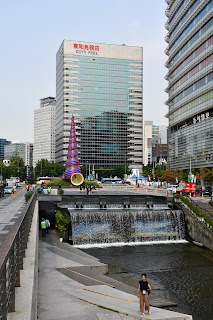Last Day in Seoul
Our last
day in Seoul started with a scenic view. We rode up the hill to the Bugak
Palgakjeong, an octagonal pavilion to the north of the historical centre of
Seoul. The weather was either cloudy or smoggy; either way, we could not see a
whole lot that day, and distant Gangnam rose faintly behind thin milky
curtains.
The view from Bugak Palgakjeong
A South Korean flag at Bugak Palgakjeong
From the
lonely top of the hill, we ended up at its very opposite: Cheonggyecheon Stream
Park, perhaps one of the most gentrified, and certainly the most tourist-heavy neighbourhoods
of Seoul. Despite not being particularly interesting from a historic
standpoint, the Cheongyecheon’s reconstruction has been a contentious political
issue. While critics deride it as an absurdly expensive motor of
gentrification, supporters point to its role in creating a new habitat for
wildlife, and in cooling down surrounding areas.
Waterfalls at Cheongyecheon
A group of tourists dressed far too outdoorsy for a venue like Cheonggyecheon
A dried up channel
We
subsequently headed to Gangnam’s Samsung D’light, a huge exposition space and
shop for Samsung’s products. More interesting than the pointlessly overwrought
exposition, though, was the protest going on outside of it. Many banners and
signs next to makeshift huts where families could camp out for days and weeks
demanded justice for Samsung’s rapaciously exploited employees. Mr J told us
that some time ago, Samsung was taken to court for a suspiciously high
incidence of cancer among its workers, but with the cause and effect practically
unprovable, Samsung got off scot-free. On that head, Mr J laconically remarked
that in South Korea, the CEO of Samsung is more powerful than the president.
Electronic boards at Samsung D'light
Protestors against Samsung
First floor of the Samsung store
Indeed, a
key word one learns when getting to know Korea is ‘chaebol,’ a large conglomerate
run by a rich and powerful family. Though chaebols have been hailed as the
motors of South Korea’s economic success, they have repeatedly come under fire
for their corrupt practices, exploitation, and monopolies, for which reason
many laws have been put in place over the years to reel in their power.
For lunch,
we had cold noodles, which still do not sit quite well with me and are
completely repulsive to my dad. After that, we rode the cable car to Seoul
Tower, where I felt like leaving all of the cold noodles – my fear of heights
kicked in and the whole building felt as though it were swaying uncontrollably.
Seoul Tower
One view from Seoul Tower
Another view from Seoul Tower
Locks at the hill's summit
Locks on faux trees
Chimneys for sending smoke signals
Kitschy decor
Well, the
earthquake was all in my head and I survived. We went downtown to the Namdaemun
(Great South Gate) area, stopping by the market, the gate itself, and the old
railway station. The pedestrian bridge to the station is actually a repurposed
railroad, much like the High Line in New York. I was very tired by then and
don’t remember doing much besides dodging pushy grandmas.
Our last
destination in Seoul was Jogyesa with its massive golden Buddhas and an
abundance of giant flower pots for lotuses. It was there that we first
witnessed Mr J practice a very Korean manoeuvre: parking a car in a tight space
with its front sticking into the street, climbing out, and then pushing it
backwards.
Small lanterns at Jogyesa
Jogyesa
Lanterns hanging from a tree
Buddha statue through the temple's window
Pagoda at Jogyesa
More lanterns hanging from a tree
A holy image at Jogyesa
Fish swimming in a circle
Detail of pagoda
Buddha statue through the main door
Water lily
In the
evening, I met a few Yalies for the last time in Korea: Michael, of course,
Rita (who graduated my year and went to the same residential college), Daisha
(whom I got to know during CET in Kunming) and Josh (the only Yalie there that
I met for the first time). We ate bingsu, a Korean dessert that can best be
compared to shaved ice.
Church in the centre of Seoul
Colourful high rise building
Yalies trying to spell out their alma mater's name with their bodies is a common sight when they meet
































Comments
Post a Comment